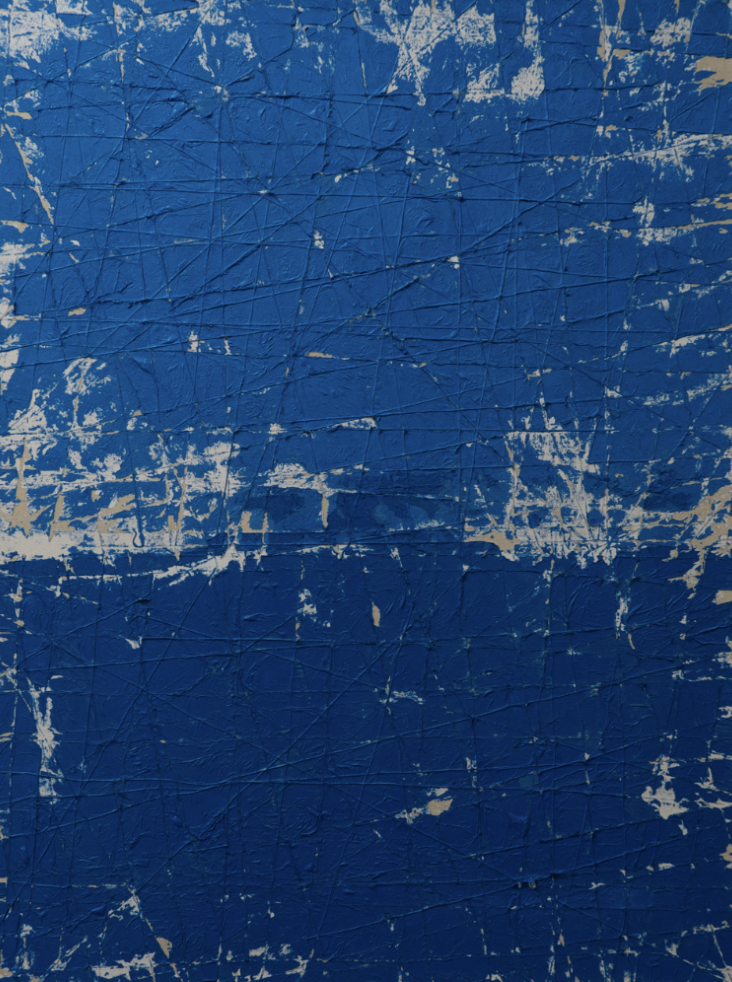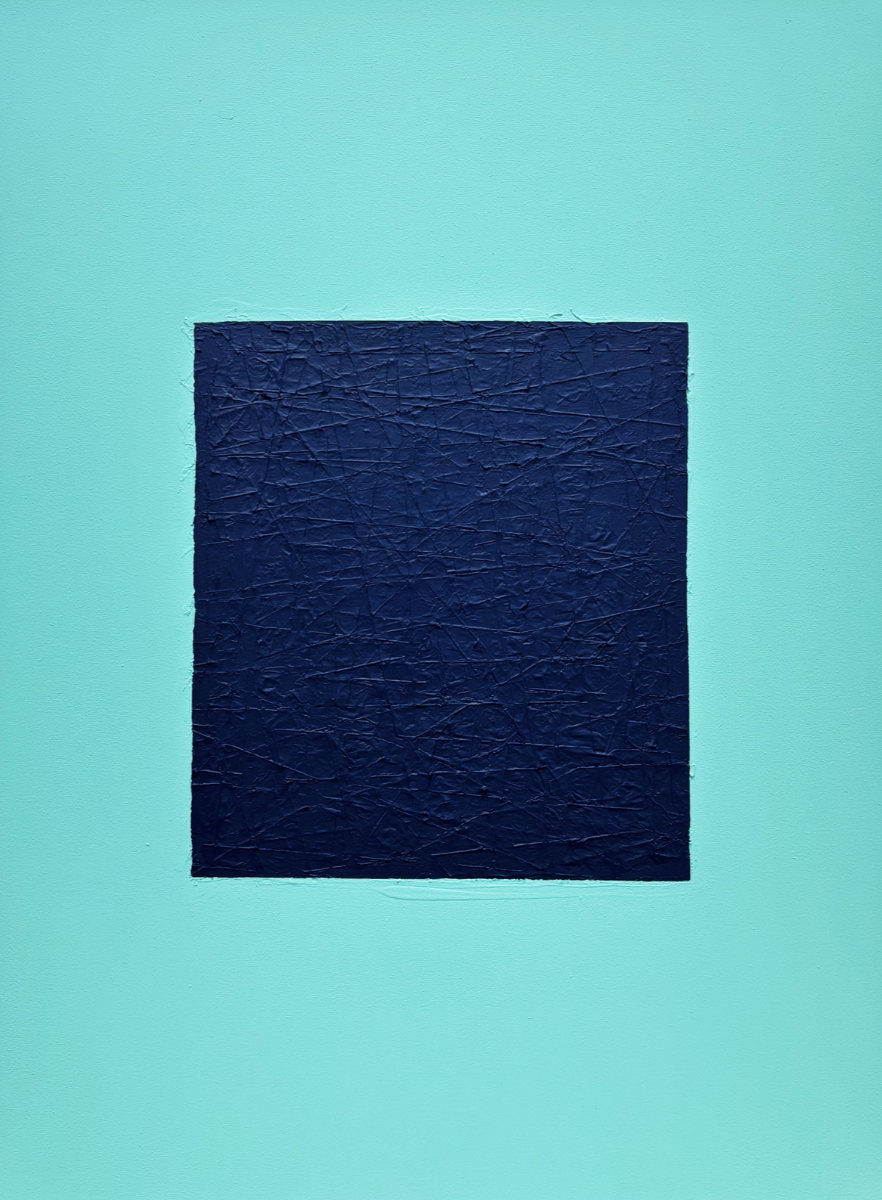Beauty Inside the Chaos: In Conversation with Jaouad Bentama
Following a near-death injury that resulted in 47 broken bones, Jaouad Bentama’s approach to art was never the same; art became his healing remedy and second chance at life. Lara Xenia speaks with Bentama about his career, artistic techniques, and personal philosophies.
Figure 1: Jaouad Bentama, Reflexion: Composition LVXVII, mixed media, 48 x 36 inches (121.92 x 91.44 cm). Photo: courtesy the artist
Lara Xenia: What materials do you gravitate towards?
Jaouad Bentama: After a near-death injury, I started using the same materials that they used to repair my body. My body was full of iron stitches and staples, so I decided to work primarily with scalpels, staples, and threads. That way, when I align or apply the lines to the side of the canvas, I can take them away, thread by thread, without knowing what’ll happen. It’s a bit of a chance result, kind of like how we all have a chance of living. I view my works as a window of life. I can convey what happened to me through the canvas. I always hope that it’ll still retain its beauty.
LX: That’s really cool. What was your experience of growing up in Paris like?
Figure 2: Jaouad Bentama, Composition XXXVI, 2024, mixed media acrylic on canvas, 48 x 36 inches (121.92 x 91.44 cm). Photo: courtesy the artist
JB: I have a Moroccan family. We grew up in the 17th and 18th arrondissements, between La Porte de Saint-Ouen and La Porte de Clignancourt. When I was about 8, I heard a lot about Gauguin, Monet, Picasso, and Renoir, all of whom I didn't know about. Then when I’d go on high school field trips to museums and I’d see Renoir’s work, I’d feel like a kid again. I was always doing small drawings because one of my neighbors used to draw. I was always drawn to painting and liked to render something super messy into something beautiful…I love finding the beauty inside of the chaos. I started my journey by drawing and going to the museum by myself while working at restaurants and at other side jobs in Paris, but I wasn’t that fulfilled. I knew in my gut that this wasn’t what I wanted to be in my life, so in 2012, I decided to leave for New York City.
I view my works as a window of life. I can convey what happened to me through the canvas. I always hope that it’ll still retain its beauty.
LX: Why New York?
JB: I had seen so many documentaries about the 1980s New York art scene, which had some of the best people. Every artist I revered stopped by NYC at one point, from Jackson Pollock to Basquiat to Edith Piaf, so I decided I was going to make something happen.
Figure 3: Jaouad Bentama, Composition XLV, 2024, mixed media acrylic on canvas, 40 x 30 inches (101.6 x 76.2 cm). Photo: courtesy the artist
LX: Did you know anyone there initially?
JB: Nobody…it was the most beautiful blague [laughs]. I did not have an apartment. In the beginning, I’d stay in a small hostel in Chelsea for weeks on end where I’d pay 75 bucks a week for about three weeks at a time. One of my friends told me I had to go to Washington Square Park, where all the artist sellers were. I’d go to Brooklyn, the Bronx, and Harlem with them and I’d start selling those drawings on a simple stoop, sitting on the chairs and following people, asking, “Hi, how are you? Do you want a drawing? Could you give me a tip?” At the end of the day, you're going to make a bit of income, but you’re still in movement.
Figure 4: Jaouad Bentama, Composition I, mixed media acrylic on canvas, 40 x 30 inches (101.6 x 76.2 cm). Photo: courtesy the artist
LX: In moments that it might have been physically or financially debilitating for you as an artist, what motivated you to keep persevering in your nascent career?
JB: I always listened to the song inside my soul that kept saying, “Stay in New York City.” I knew it was not gonna be that easy, but I stayed and focused on what I could do. I had so many struggles and didn’t know how I was gonna stay or make an income. It's a tough city in some ways, but also a beautiful one because during that time, I learned how to talk to people and sell my work. You win every day by being alive. In my mind, I kept reminding myself, “I’m a winner” and I built resilience. After all, I am a son of an immigrant and I have that in my blood.
When I first moved to the city, I was meeting new people and seeing the art scene, getting immersed in the art collectives in the Lower East Side. I used to have a crew of friends making art in the inside of a big basement in Ludlow Street. I then moved to an artist collective, where I realized others were struggling just as much, if not more. We all supported each other. We’d go to shows in Brooklyn or Queens and pitch in for installations. Someone would get a bit of money for their project and share opportunities, then one day, I got inspired to make works based on Mickey Mouse and got some recognition and income from that.
Figure 5: Jaouad Bentama’s studio. Photo: Lara Xenia
Then my life changed. In Tulum in 2021, a truck hit me while I was on a scooter, and another motorcycle ran over me thereafter. I broke 47 bones, fell into a coma, and they rebuilt my chest with plates. I spent a month-and-a-half in a hospital away from everyone I knew and was left for dead on the road, but somehow I survived. Without art, I would not have healed. That is where my story begins. I could have cried for myself, but instead I chose to move forward. Maybe the accident was a gift from God, like a chance to create something bigger than me. After a year and a half of therapy, when I could not move my arm or walk properly, I became more intentional and introspective. I didn’t want to just make art, but to live it, write it, and move through it.
I was deconstructed, rebuilt, and began creating again. The body is an incredible vessel and to heal, it needs peace and good energy. Since then, I have chosen to be myself fully through my canvases. That is why I turned to strings, since I was sewn back together. I am also really inspired by artists like Nicolas de Staël and Simon Hantaï, so I wanted to experiment with my modes of production.
Figure 6: Jaouad Bentama, Composition XLII, mixed media, acrylic on canvas, 40 x 30 inches (101.6 x 76.2 cm). Photo: courtesy the artist
Figure 7: Nicolas de Staël, Composition sur Fond Rouge, 1951, oil on canvas, 31.88 x 21.25 inches (81 x 54 cm). Photo: courtesy Mitchell-Innes & Nash
I was deconstructed, rebuilt, and began creating again.
LX: Gosh, that’s really incredible; I am glad you are alright now. Do you rip the thread across the surface?
JB: Yes, it's a lot of layers because the more layers you put, the more you heal because after that, I unframed them, and put a different frame after. I can rip the thread, until it stops. [Points to work] For the black-and-white piece, I put a lot of stitches into it, using the materials from my surgery directly on the canvas. It’s not easy to create, because as a painter I don’t just paint on top. I work with materials, layering pain, life, and scars. Each layer reminds me of what I’ve lived through, but also what others carry. I call that piece Healing in New York. I use the products of my accident, like staples, stitches, patches, layer after layer, just like the ones all over my body. I’m also experimenting with using street posters and advertisements as a base layer for some of my newer works.
Figure 8: Jaouad Bentama, Composition, mixed media acrylic on canvas, 72 x 60 inches (182.88 x 152.4 cm). Photo: courtesy the artist
LX: It’s beautiful; it’s literally like you're suturing the piece.
Figure 9: Studio view of posters. Photo: Lara Xenia
JB: Voilà. That, for me, is the meaning of creating. You see a shadow inside, then another color, then layer after layer, you step back, you come close, and you step back again. This one is still neat, and almost varnished. I leave it that way, so people can experience it from multiple dimensions. Sometimes it takes a month just to finish one piece, but that’s what makes it new and different. I want my work to be silent, like a dialogue between you and the canvas. It should pull you into a zone…
LX: Yes, tell me a bit about your Tiffany & Co. series.
Figure 9: Jaouad Bentama, Composition XLI, 2024, mixed media acrylic on canvas, 48 x 36 inches (121.92 x 91.44 cm). Photo: courtesy the artist
LX: Yes, tell me a bit about your Tiffany & Co. series.
JB: I have made around 15 pieces for them. My work is currently in Riyadh, Bangkok, and other locations. I especially love making these square ones. I always try to combine my work with something deeply psychological, so the viewer feels a sense of peace.
Figure 10: Jaouad Bentama, Blue: Composition LV, 2025, mixed media acrylic on canvas, 48 x 36 inches (121.92 x 91.44 cm). Photo: courtesy the artist
Figure 11: Installation view of Jaouad Bentama, Composition LV, LVI, and LIV, 2024, mixed media acrylic on canvas, 48 x 36 inches (121.92 x 91.44 cm). Photo: courtesy the artist
LX: How did you find solace within the studio, and also within companions you had?
JB: By myself. I love to work with la dualité. I’m always asking questions. The day I stop asking questions, my art will die.
LX: What are the questions you ask yourself on a given day?
JB: “Are you still here?” It’s the deepest question I can ask—because what is the mind, if not presence? That question keeps me grounded in the present moment. It’s a way to survive pain and to keep creating. Each stitch, each layer of pain, and each color was part of that story of being alive again. A window into the soul…I was supposed to die. But I survived. And that survival turned out to be a gift.
Jaouad Bentama
Photo: Emmanuel Giraud
Jaouad Bentama (b. Paris, France) moved to New York in 2012, immersing himself in the city’s artist collectives before joining Mana Contemporary in 2017. His work explores memory, identity, and cultural displacement through layered surfaces that reflect both personal and collective histories. In December 2021, a severe accident followed by a coma in Tulum, Mexico profoundly transformed his practice. From this rupture emerged the central motif of his work: the tear. Bentama, the tear is not merely a scar but a threshold, a space where trauma and rebirth coexist, a mark of survival and shared vulnerability. In his ongoing series Les Déchirures, he layers acrylic, ink, torn paper, and raw canvas to create textured reliefs landscapes of memory and repair where absence becomes presence and damage turns into beauty. Through his art, Bentama creates a powerful language of endurance and poetic expression, transforming fragility into strength.














